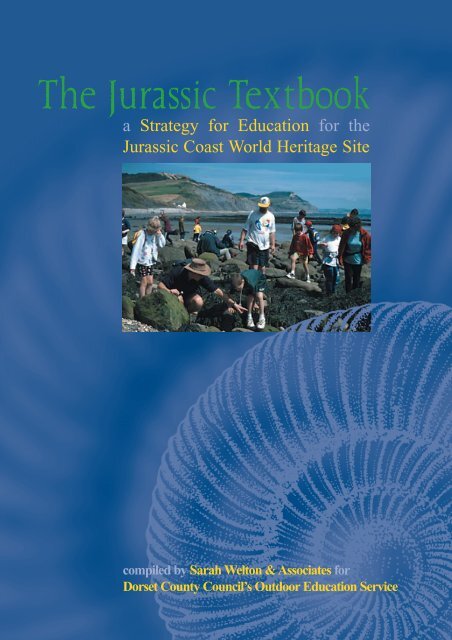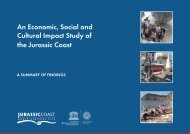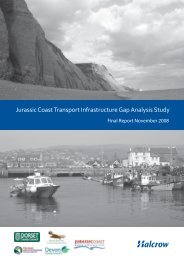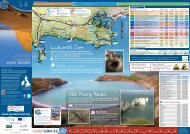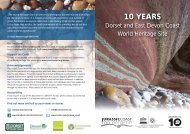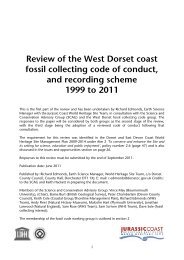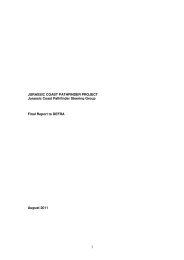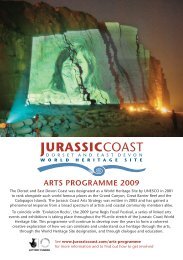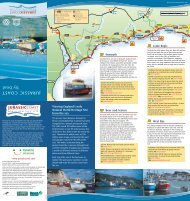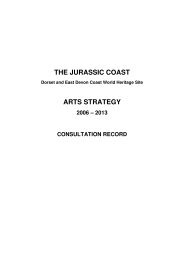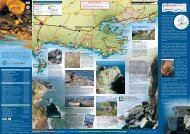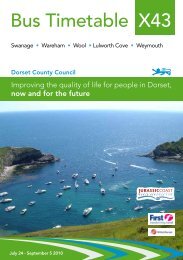whole book - Jurassic Coast
whole book - Jurassic Coast
whole book - Jurassic Coast
- No tags were found...
Create successful ePaper yourself
Turn your PDF publications into a flip-book with our unique Google optimized e-Paper software.
a Strategy for Education for the<strong>Jurassic</strong> <strong>Coast</strong> World Heritage Sitecompiled by Sarah Welton & Associates forDorset County Council’s Outdoor Education Service
Contents1. Introduction 12. Our Aims 53. What is the Education Strategy for the <strong>Jurassic</strong> <strong>Coast</strong> 74. The Resource 135. Opportunities and Constraints 216. Our Vision for the effective educational use of the <strong>Jurassic</strong> <strong>Coast</strong> 257. Our Approach to education on the <strong>Jurassic</strong> <strong>Coast</strong> 278. Our Audiences 299. Our Policies 3510. Time for Action 5511. Implementation of the Education Strategy 5712. Evaluation of the Education Strategy 61Appendix 63
1. Introductionpage 1
page 2
The <strong>Jurassic</strong> <strong>Coast</strong> World Heritage Site is a world-famous educationalresource. Historically, it has played a key role in the study of Earthsciences. Today, the superb exposures afforded by the coast are of globalimportance, studied by geologists and geomorphologists from all overthe World. It is our duty to manage our World Heritage Site effectively.Education is crucial for the successful implementation of all aspects ofmanagement - education is the most powerful management tool.Education promotes• Understanding• Appreciation• The need for concern• Individual and collective responsibilityAll these are necessary to ensure a co-operative approach tomanagement.There are currently many excellent educational initiatives on the <strong>Jurassic</strong><strong>Coast</strong>, run by a range of different organisations, providing resources andservices for all levels and target audiences. It is this variety that makes thecoastline a world-class teaching resource. It is crucial that theindividuality of existing initiatives is preserved but they must be coordinated,supported and promoted more effectively.For the purpose of this strategy, the following assumption is made:We are educated from cradle to grave - Lifelong Learning.page 3
Types of education are defined as:• Formal education - education within schools at all levels, collegesand universities• Non-formal education - education of organised groups, outside theformal education system• Informal education - education of the general publicTo educate, we need to provide:• Information - intelligence given - purely factual• Interpretation - “An educational activity which aims to revealmeanings and relationships through the use of original objects, byfirst-hand experience and by illustrative media, rather than simply tocommunicate factual information” (Freeman Tilden)• Facilities• InspirationWe learn when there is:• Active involvement - people retain about 10% of what they hear,30% of what they read, 50% of what they see and 90% of whatthey do• Relevance to everyday experience• Curiosity and interest generated• Personal contact to convey and promote messages• Enjoymentpage 4
2. Our Aimspage 5
Through education, the World Heritage Site can:2.1 Increase awareness of the importance of thegeology, the completeness of the geologicalsuccession and coastal change.2.2 Increase awareness of geological time (‘deep time’)in the UK and beyond.2.3 Ensure that the local community, decision-makersand visitors to the coast fully understand thesignificance of World Heritage status and theimportance of the <strong>Jurassic</strong> <strong>Coast</strong> in a national andglobal context.2.4 Give the local community a sense of pride andownership for ‘their’ world-class coast and theopportunity to get involved in its management.2.5 Inspire an interest in geology, which can be builtupon.2.6 Develop appropriate educational tourism.2.7 Protect the coastal environment.2.8 Contribute to the knowledge, skills and attitudesrequired by the National Curriculum andexamining groups.page 6
3. What is theEducationStrategy forthe <strong>Jurassic</strong><strong>Coast</strong>?page 7
The Education Strategy for the <strong>Jurassic</strong> <strong>Coast</strong> provides a framework,within which all educational initiatives (existing and new) focus on the<strong>Jurassic</strong> <strong>Coast</strong> as a resource and work together to ensure that all aspectsof <strong>Jurassic</strong> <strong>Coast</strong> and World Heritage education are really effective.3.1 The Aim of the StrategyThe aim of the strategy is to recommend ways in which:• Existing educational initiatives, relevant to the <strong>Jurassic</strong> <strong>Coast</strong>, can besupported, utilised and co-ordinated more effectively.• Existing educational initiatives can be broadened to ensure that themessages of the <strong>whole</strong> <strong>Jurassic</strong> <strong>Coast</strong> ‘story’, in a national,international and global context, are included.• The role of education and training can be promoted in developing thesocio-economic benefits of World Heritage status for the <strong>Jurassic</strong><strong>Coast</strong>.• The quality of teaching and learning in, for and about the <strong>Jurassic</strong><strong>Coast</strong> World Heritage Site can be raised.• Needs and gaps in educational provision can be identified and filled.• New educational opportunities can be developed.• Local communities can become more involved with educationalinitiatives on ‘their’ coast.• Community-based and other educational and training initiatives,concerned with management of the <strong>Jurassic</strong> <strong>Coast</strong>, can be developedin the ‘gateway’ towns and their hinterland.• Appropriate educational tourism is encouraged in accordance withtourism strategies.page 8
• Visitors to the <strong>Jurassic</strong> <strong>Coast</strong> can have ‘positive’ educationalexperiences.• Partnerships between providers and users can be developed, andsustained, to deliver the agreed policies.The strategy recognises:• The importance of preserving the individuality of existing initiatives,whilst introducing common <strong>Jurassic</strong> <strong>Coast</strong> themes.• That <strong>Jurassic</strong> <strong>Coast</strong> themes should not be the only topic covered byeducational initiatives but should be integrated into much widereducational programmes.• That the university ‘anchor’ towns of Bournemouth and Exeter shouldhave an important role to play in access to the <strong>Jurassic</strong> <strong>Coast</strong> and thecoastal ‘gateway’ towns should be a focus for <strong>Jurassic</strong> <strong>Coast</strong>education.• That many commercial interests on the <strong>Jurassic</strong> <strong>Coast</strong> are using theWorld Heritage Site in their promotional material and that carefulconsideration needs to be given to quality control of <strong>Jurassic</strong> <strong>Coast</strong>accredited educational initiatives.3.2 The TasksThe tasks of the Education Strategy for the <strong>Jurassic</strong> <strong>Coast</strong> are to:• Identify existing educational initiatives, relevant to the <strong>Jurassic</strong> <strong>Coast</strong>• Identify audiences• Respond to needs and identify gaps in educational provision• Identify opportunities for educationpage 9
• Identify constraints and limitations for education• Engage a wide range of participation in education on the<strong>Jurassic</strong> <strong>Coast</strong>• Establish an Education Policy for the <strong>Jurassic</strong> <strong>Coast</strong>• Develop a co-ordinated approach to implementation of the EducationStrategy• Provide guidelines for further strategies and action plans• Evaluate the Education Strategy3.3 Key ElementsThe key elements of the <strong>Jurassic</strong> <strong>Coast</strong> Strategy for Education are:Our VisionA clear vision for the effective educationaluse of the <strong>Jurassic</strong> <strong>Coast</strong>Our ApproachAn agreed co-operative approach toeducation on the <strong>Jurassic</strong> <strong>Coast</strong>Our PoliciesEducational policies for the <strong>Jurassic</strong> <strong>Coast</strong>Time for Action!A detailed Action Plan for education on the<strong>Jurassic</strong> <strong>Coast</strong> (see enclosed Action Plan)page 10
3.4 Moving ForwardThe Education Strategy for the <strong>Jurassic</strong> <strong>Coast</strong> has been developedthrough wide consultation. The views of relevant organisations andindividuals involved in education on the Dorset and East Devon coast,and education in the broader sense, have been taken into account in thepreparation of this document. However, the process does not end herebecause all consultees agreed that the Strategy should, in addition tolong-term goals, identify actions which could be implemented quickly sothat the process of raising awareness of the significance of the WorldHeritage Site could start at once. As the actions are implemented andnew opportunities arise, the Action Plan must be reviewed and updated.As many of the actions are short-term and progress should be madequickly, it is recommended that the Strategy be reviewed annually.Evaluation should be built into the planning of all actions and carried outat all stages of implementation.Although the Strategy for Education is a framework for educationalinitiatives, it is sufficiently flexible to allow for unforeseen educationalopportunities.The <strong>Jurassic</strong> <strong>Coast</strong> Strategy for Education is a livingdocumentpage 11
page 12
4. TheResourcepage 13
4.1 The <strong>Jurassic</strong> <strong>Coast</strong> itself (see enclosedmap)The East Devon and Dorset coastline was designated aWorld Heritage Site in December 2001 on the groundsof the fact that it is one of the most significant Earthscience sites in the world. In just 95 miles of coastline,exposed in the cliffs for all to see, is a near-continuous sequence ofrocks, telling the story of almost 185 million years of the history of theEarth, spanning almost the <strong>whole</strong> Mesozoic Era. It displays not justsuperb <strong>Jurassic</strong>, but older Triassic and younger Cretaceous rocks too. Thecoast also boasts many coastal geological and geomorphologicalfeatures such as the Lulworth Crumple and Durdle Door and yieldssuperbly preserved fossil remains. Many major contributions to sciencehave been made along this coast for hundreds of years. Now it providesa famous resource for teaching Earth sciences.The <strong>Jurassic</strong> <strong>Coast</strong> qualified for World Heritage Status onthe grounds of the following criterion:“The Site should be an outstanding example,representing major stages of the Earth’s history,including the record of life, significant ongoinggeological processes in the development oflandforms, or significant geomorphic orphysiographic features”UNESCOIn addition to this physical resource, there are the human stories. Forexample, who has not been touched by the story of Mary Anning, whodevoted her life to the search for the finest vertebrate specimens at LymeRegis in the early nineteenth century? Such stories bring history alive.page 14
There is evidence of past and present mineral extraction along the lengthof the <strong>Jurassic</strong> <strong>Coast</strong> from Mesolithic tools and Bronze Age shaleworkings to modern day stone quarrying, sand, gravel and gypsumextraction and oil exploration. The use of stone from the <strong>Jurassic</strong> <strong>Coast</strong>,particularly Beer, Purbeck and Portland, for significant buildings providesrelevance to the lives of visitors from other parts of England and thecurrent use of Portland stone for sea defences throughout Europeprovides wider links.The use of local building stone is a major factor in the local character oftowns and villages in Dorset and East Devon and has been the inspirationof generations of writers, painters and sculptors.The diversity in rock formations provides a wide range of wildlifehabitats: chalk and limestone cliffs and downland; other cliffs of clay,shale and sandstone; unstable undercliffs with landslips or mudflows;beaches with sand, shingle or dunes; inlets and harbours with mud flats,marshes and reed beds. We must not forget, either, that the ‘landscape’and scenery beneath the waves is as varied and dramatic as that above.The <strong>Jurassic</strong> <strong>Coast</strong> is the interface between land and sea, linking theunique and varied hinterland with the rich marine environment. Theseabed is not a desert. There are plains and ridges, rocky reefs and ledges- you only need to look at an Admiralty chart or take an echo soundingto see for yourself. Even the remains of eroded cliffs form underwaterreefs. These provide a diverse range of marine habitats. Rocky reefsprovide hiding places for shellfish, shaded overhangs provide just theright conditions for anemones, corals and fan worms to thrive and ahard surface for seaweeds and plant-like animals to hang on to.page 15
Soft sands, gravels and mud provide the perfect habitats for burrowinganimals. The <strong>Jurassic</strong> <strong>Coast</strong> is, therefore, much studied by ecologists andmarine biologists and enjoyed by amateur naturalists. Many of theDorset and East Devon coast’s important wildlife habitats are protectedby local, national, European and international designations.4.2 Some of the current educational initiatives relevantto the <strong>Jurassic</strong> <strong>Coast</strong> World Heritage Site (fordetailed descriptions of key initiatives seeAppendix)The enclosed map shows examples of educational initiatives on the<strong>Jurassic</strong> <strong>Coast</strong>. It is not a complete list and exciting new initiatives areplanned in the near future.4.3 Accommodation on the <strong>Jurassic</strong> <strong>Coast</strong>Accommodation for visiting educational groups includes:• Field study and activity centres• Youth Hostels at Swanage, Lulworth, Portland and Beer• Caravan sites• Guest houses, hotels and bed and breakfasts. A number of visitinggroups stay in the Poole and Bournemouth area and visit the <strong>Jurassic</strong><strong>Coast</strong>. A few guesthouses in Swanage take school parties outside themain tourist season, but the number is dwindling.page 16
The Weymouth and Portland Teachers’ Guide provides a list ofaccommodation in the Weymouth and Portland area - some 27hotels. However, the only cheap, hostel-type accommodation in thearea, suitable for <strong>whole</strong> classes, is at 3-D Education + Adventure,Osmington and at the Portland Youth Hostel. Proposals are underdiscussion over Phase 2 of the development of the hostel to provideadditional accommodation together with an educational resourcecentre.There is very little accommodation for groups in West Dorset and EastDevon. In Lyme Regis there are, currently, only one hotel and a hostelwhich provide accommodation for educational groups and the future ofthese is uncertain. In East Devon, there is some potential to encouragebed and breakfasts and guesthouses to provide accommodation foreducational groups out of the main tourist season.The demand needs to be ascertained and a co-ordinated approachtaken. In addition to other accommodation providers in East Devon,there is the potential of student accommodation at weekends andduring the college holidays at Bicton College and caravan siteaccommodation on the coast. The issue of accommodation cannot bereconciled through the implementation of this strategy, it needs to beaddressed through Local Plans, AONB Plans and Market Town Strategies.In compiling this strategy, it was found that although coastalcentres, e.g. the Charmouth Heritage <strong>Coast</strong> Centre, haveinformation on where visiting schools come from and where theystay, this information is not available for the <strong>whole</strong> coast. It isrecommended that a detailed study be carried out (see Time forAction).page 17
4.4 Information and InterpretationThe <strong>Jurassic</strong> <strong>Coast</strong> currently has a chain of visitor centres and relevantmuseums (see Education and Interpretation on the <strong>Jurassic</strong> <strong>Coast</strong> map),each focusing on different themes and exhibiting different styles ofinterpretation. This diversity is seen as a huge asset to the <strong>Jurassic</strong> <strong>Coast</strong>as, by visiting these facilities, visitors can have a truly comprehensivecoastal experience. Centres are currently networking through groupssuch as Dorset <strong>Coast</strong>link and the Purbeck Information and Field StudiesGroup.It is important that, whilst introducing common <strong>Jurassic</strong> <strong>Coast</strong>themes, this vast diversity is not lost.4.5 Guided Walks, Events and Boat Trips4.5.1 The Dorset Countryside Guide offers a comprehensiveprogramme of guided walks and events throughout the Countyand throughout the year on a wide range of different subjects.These walks are led by experts and rangers for a number of localorganisations. There are many walks and events on the Dorset<strong>Coast</strong>. In the east of the County (Poole and Bournemouth area),walks and events are published in The Greenlink Guide. Inaddition, individual sites organise walks and events on a regularbasis. These include: the National Trust at Studland, DurlstonCountry Park, the Purbeck Marine Wildlife Reserve at Kimmeridge,the Lulworth Heritage Centre, the Chesil Beach Centre andCharmouth Heritage <strong>Coast</strong> Centre. Weekly fossil walks atCharmouth are so popular that up to 300 participants have beenrecorded (an approximate average of 70 participants). Thisproblem is being addressed.page 18
4.5.2 East Devon <strong>Coast</strong> and Countryside Guided Walks aretailored to the needs of the group and include World Heritage<strong>Coast</strong> walks. ‘Celebrating the East Devon <strong>Coast</strong>’ is a summerweek-long programme of activities: walks, talks, trails, and eventscelebrating the South West <strong>Coast</strong> Path and the World HeritageSite.In 2003, a programme of walks and events for the World HeritageSite has been produced.4.5.3 Boat Trips operate from Exmouth, Beer, Lyme Regis,Weymouth, Lulworth, Swanage, Poole and Bournemouth.4.5.4 Talks, Lectures, Workshops and Classes are run by anumber of organisations including Workers’ EducationalAssociation (WEA); Dorset County Museum; the National Trust;Weymouth College; Universities; various geological societies;Wildlife Trusts and Town Associations.page 19
page 20
5. OpportunitiesandConstraintspage 21
The opportunities for education on the <strong>Jurassic</strong> <strong>Coast</strong> are enormous andinclude:• The <strong>Jurassic</strong> <strong>Coast</strong> itself - the physical resource, within the widercontext of the Dorset and East Devon coast and its hinterland• The scenic value of the <strong>Jurassic</strong> <strong>Coast</strong>• The location of the <strong>Jurassic</strong> <strong>Coast</strong> - its position on the south coast ofEngland, its proximity to London and the southeast, its ease of accessfrom London and from the continent• The wide range of existing facilities and educational initiatives• Local expertise and volunteer support• Appealing and exciting interest - a resource containing dinosaurfootprints, ammonites and ichthyosaurs, human stories and much,much moreThe constraints for education on the <strong>Jurassic</strong> <strong>Coast</strong> must be consideredin implementing this strategy and include:• Visitor pressure at certain sites• Other coastal uses, e.g. Ministry of Defence ranges• Access to much of the <strong>Coast</strong> is difficult or impossible. Safety mustalways be a prioritypage 22
• Environmental constraints include wildlife conservation measures,e.g. restricted access during bird-nesting seasons• Land ownership and access• Public relations, e.g. local sensitivities and privacy• Safety. Risk assessments are crucial to all educational activities on the<strong>Jurassic</strong> <strong>Coast</strong>• Financing of individual educational initiatives• Increasing demands for volunteer timeThe education strategy must be integrated into other strategies andmanagement plans for the <strong>Jurassic</strong> <strong>Coast</strong>. These include:• World Heritage Site Management Plans• Dorset <strong>Coast</strong> Strategy• Areas of Outstanding Natural Beauty Management Plans• Local Plans• Conservation Management Planspage 23
page 24
6. Our Visionfor theeffectiveeducationaluse of the<strong>Jurassic</strong> <strong>Coast</strong>page 25
This strategy is based on achieving a vision for education in the future. Ifour vision becomes a reality, the strategy has been successful.6.1 The <strong>Jurassic</strong> <strong>Coast</strong> as a focus for Earth sciencestudies worldwide.• All aspects of the <strong>Jurassic</strong> <strong>Coast</strong> studied from a distance• All Earth scientists and educational groups obtaining maximumbenefit from visits to the <strong>Jurassic</strong> <strong>Coast</strong>• The <strong>Jurassic</strong> <strong>Coast</strong> offering world-class field studyaccommodation and resources6.2 All educational initiatives, which focus on the<strong>Jurassic</strong> <strong>Coast</strong>, working together effectively.• Effective networks and communication in place• Sharing of resources and expertise• Agreed common messages disseminated6.3 All visitors to the <strong>Jurassic</strong> <strong>Coast</strong> leaving inspired tolearn more.6.4 The local community having a pride and sense ofownership for the <strong>Jurassic</strong> <strong>Coast</strong>.• Local people of all ages involved in projects on ‘their’ coast6.5 The local community, visitors to Dorset and EastDevon and the wider public in the UK andworldwide understanding, and excited by, newEarth science and educational research and fossilfinds from the <strong>Jurassic</strong> <strong>Coast</strong> and the significance ofWorld Heritage Site status.page 26
7. OurApproach toeducation onthe <strong>Jurassic</strong><strong>Coast</strong>page 27
We will implement the Education Strategy by taking the followingagreed approaches:• Making the most of existing resources• Co-operation and sharing• Effective communication using the best new technology• Careful quality control• Innovation• Developing links• Taking advantage of opportunities• Retaining local distinctiveness• Evaluating our progress throughoutpage 28
8. OurAudiencespage 29
8.1 Formal Education• Schools• Colleges• UniversitiesThis audience includes:• Local educational establishments, which currently use the <strong>Jurassic</strong><strong>Coast</strong> as a teaching resource - for fieldwork, data collection, projectwork and other curriculum-related and recreational visits.• Groups visiting from other areas.• Subject Associations, e.g. Geographical Association, Association forScience Education, Earth Science Teachers’ Association, GeologicalSociety (of London) and the Royal Geographical Society with Instituteof British Geographers.The <strong>Jurassic</strong> <strong>Coast</strong> is a classic fieldwork site. A large number of groupscurrently visit and/or carry out classroom studies of famous features suchas Old Harry Rocks and examples of coastal geology and processes suchas Lulworth Cove and Durdle Door, which are required to be studied inthe National Curriculum and examination syllabuses. Although groupsstaying in Field Study Centres and/or planning their visit with the help oflocal experts are able to get the most out of their visit, others gain verylittle from their visit apart from it being a coastal ‘holiday’ - at best aconfused series of unrelated visits; at worst, misinformation.page 30
Throughout this strategy, we mustask the question: What do teachersneed to enrich their curriculum?Some relevant areas of the Curriculum (for moredetailed information, see enclosure)National Curriculum Subjects at Key Stages 2 - 4:Science• Ideas and Evidence in Science• Changing Materials - physical and geological change.Year 3 topic on ‘Rocks and Soils’ is particularly relevantGeography• Geographical enquiry and skills• Knowledge and understanding of places- The national, international and global contexts of places- How and why changes happen in places and the issuesthat arise from these changes- How places are interdependent and the idea of globalcitizenshipPlace = Structure + process (physical and human) + time(geological and human)The QCA strategy for geography includes a Year 6 topic on‘<strong>Coast</strong>s’.page 31
CitizenshipThere is a growing emphasis on citizenship in the NationalCurriculum.• Awareness of our cultural heritage and that of other culturesand traditions.This is good news for teachers who support the internationaldimension of the curriculum as it is the most effective way ofproviding the knowledge, experiences and skills that will helpyoung people become effective global citizens. The issue ofsustainability is an integral part of the study of citizenship.Sustainability is a key element of <strong>Jurassic</strong> <strong>Coast</strong> management.ICTThe world-wide geological links and the internationaldimension of World Heritage status provide opportunities toexchange and share information (e.g. video conferencing, webpublishing and e-mail).In addition, studying the <strong>Jurassic</strong> <strong>Coast</strong> can develop skills inlanguage and communication, mathematics (data handling),history, art and design - examining how the coast has inspiredgenerations of artists can be used as a ‘springboard’ forchildren’s work - and physical education.At GCSE, AS/A Level:The <strong>Jurassic</strong> <strong>Coast</strong> is a classic site for geology and geography inall syllabuses. Edexcel Geography GCSE syllabus includes a<strong>Coast</strong>al Management Unit. In addition to the physical aspectsof the <strong>Jurassic</strong> <strong>Coast</strong>, human issues, e.g. management,recreational pressures and other economic issues are studied onfield visits. At higher levels, <strong>Coast</strong>al Zone Management andtourism are frequently studied.page 32
8.2 Non-Formal Education• Organised groupsThis has been identified as an importantaudience, especially in relation to raisingthe awareness of the local community and getting the people involved.Local groups can provide a communication route to the community. Aclear message, included in all relevant talks to local community groupswill be more effective in targeting a wide audience than promotionalleaflets. Groups can provide expertise and the necessary framework forinvolvement at all levels.On the Dorset and East Devon coast there are many relevant communitygroups, which should be encouraged to become involved with educationon the World Heritage Site. These include:• Local interest societies, e.g. the Purbeck Society• Town Partnerships• Ahead Groups• Residents’ Associations• Environment Groups, e.g. Lyme Regis and District Environment Group• Geologists’ Association Groups• Open University Geological Society• Dry Stone Walling Association (South-west)• Dorset Industrial Archaeology Society• Council for the Protection of Rural England area groups• Ramblers’ Association• Wildlife Trust local groups and WATCH groups• National Trust groups• Womens’ Institutes• Townswomens’ Guilds• Parent Teacher Associations• Workers’ Educational Associationpage 33
8.3 Informal Education• The General PublicThis can be divided into:- The local community- Local service providers who meet visitors to the <strong>Jurassic</strong><strong>Coast</strong>- General tourists on holiday- ‘Pilgrims’ to the World Heritage Site- Earth scientists and collectorspage 34
9. OurPoliciespage 35
1. Co-ordinating existing and new educational initiatives.2. Providing educational resources to fill gaps in existingprovision.3. Co-ordinating the effective use of field study facilities as afocus for <strong>Jurassic</strong> <strong>Coast</strong> education.4. Encouraging and supporting local schools and colleges totake a leading role in <strong>Jurassic</strong> <strong>Coast</strong> education.5. Bridging the gap between Earth science and the public.6. Disseminating clear <strong>Jurassic</strong> <strong>Coast</strong> messages.7. Developing national and international links.page 36
Policy 1Co-ordinating existing and new educationalinitiatives relating to the <strong>Jurassic</strong> <strong>Coast</strong>RationaleBy making effective use of existing and new initiatives, we will achieve ouraims of awareness raising (Aims: 2.1, 2.2, 2.3, 2.5) and formal education(Aim: 2.8) with the knock-on economic and environmental effects (Aims: 2.6,2.7).ObjectiveTo encourage better communication, understanding and sharing betweencoastal education providers in Dorset and East Devon and beyond.Actions• To establish a World Heritage Site Education Working Group.• To appoint a World Heritage Site Education co-ordinator.• To maintain an ongoing audit of educational initiatives on the <strong>Jurassic</strong><strong>Coast</strong>.• To establish a <strong>Jurassic</strong> <strong>Coast</strong> education network.• To develop effective internet links between <strong>Jurassic</strong> <strong>Coast</strong> educationproviders.page 37
Policy 2Providing educational services andresourcesRationaleBy responding to needs and filling gaps, we will achieve a fully comprehensiveeducational programme, achieving our aims of awareness raising (Aims: 2.1,2.2, 2.3, 2.5) and formal education (Aim: 2.8) with the knock-on economicand environmental effects (Aims: 2.6, 2.7).Objective 1To ensure that all important aspects of the <strong>Jurassic</strong> <strong>Coast</strong> are covered andeducational groups, visiting the <strong>Jurassic</strong> <strong>Coast</strong>, get the maximum benefit fromtheir visit.Actions• To develop <strong>Jurassic</strong> <strong>Coast</strong> Learning Trails - directories of sites to visit aimedat different levels (National Curriculum Key Stages 2, 3 and 4, AS/A2 Leveland at tertiary level). These should be practical guides for teachers bringinggroups to the <strong>Jurassic</strong> <strong>Coast</strong>, appropriate to the level and study topic. Theimportance of visiting sites in the recommended order to build thegeological ‘story’ must be emphasised. Sites should be classified forseasonal suitability, group size suitability and access and alternativesincluded, where appropriate, to spread the load. Appropriate ‘View Points’should be identified and recommended. Safety information must be given.page 38
<strong>Jurassic</strong> <strong>Coast</strong> Learning Trail topics might include:- Geological Time Trail- <strong>Coast</strong>al Change Trail to include coastal engineering issues- Geology and Industry Trail - stone/gypsum/oil- World Heritage Site Management Trail- <strong>Jurassic</strong> <strong>Coast</strong> Ecology Trail - varied geology leads to varied coastaland marine habitats- Art and Design on the <strong>Jurassic</strong> <strong>Coast</strong>- History of the study of Earth sciences• To produce and distribute a <strong>Jurassic</strong> <strong>Coast</strong> school visits brochure toprovide practical information on facilities, accommodation, safety,etc.• To maintain a web-based list of accommodation provision for groupsvisiting the <strong>Jurassic</strong> <strong>Coast</strong>. Actively encourage and support theprovision of additional accommodation, especially in West Dorset andEast Devon, in co-operation with Tourist Information Centres. Adetailed survey of which groups visit and where they stay should becarried out. Opportunities, for example caravan parks and collegeaccommodation at weekends and holidays, should be examined.• To encourage and support a sharing of resources whereby <strong>Jurassic</strong><strong>Coast</strong> field study centres make expertise, facilities, etc. available togroups staying in ‘accommodation only’ establishments (e.g.classroom accommodation for evening use, teaching assistance,teaching materials).page 39
Objective 2To enable learners at all levels to study the <strong>Jurassic</strong> <strong>Coast</strong> from a distance,wherever they are in the world.It is recognised that it is becoming progressively more difficult forschools to take students out of school, for financial, organisational,curricular, safety or practical reasons.Popular sites, e.g. Lulworth Cove, are under a great deal of pressurefrom educational use.It is now acceptable, at most levels and in most subject areas, to sourceand use data that has been collected elsewhere.Action• To produce a ‘Virtual Field Trip’ website resource.Website to include:- Maps - GIS-based overlays- Aerial video - ‘flight along the coastline’- Photographs - historical and current- Case Study material - management of the World Heritage Site, erosionand coastal engineering, tourism, etc.- Data Sets- Recent fossil discoveries and Earth science research findings- Erosion monitoring data - LIDAR- Curriculum guidance- <strong>Jurassic</strong> <strong>Coast</strong> Learning Trail material- Accommodation advice for field visitspage 40
- Links to school, college, museum and other websites- Information for parents, who wish to visit sites on the <strong>Jurassic</strong><strong>Coast</strong> with their children to help children with special needs or toenrich their children’s classroom workThe Virtual Field Trip Website must provide teachers with everything theyneed to study the <strong>Jurassic</strong> <strong>Coast</strong> in the classroom. Although visits shouldbe encouraged, they are not imperative and when visits are made to seeselected sites ‘for real’, the students are already familiar with the <strong>whole</strong>coast and visited sites can be seen in the context of the geological story.• It is important that the website is not in competition with visitorcentre retail opportunities.• The Virtual Field Trip Website must be dynamic and develop and beupdated regularly.• The Virtual Field Trip Website materials must be easily downloaded inA4 format and suitable for photocopying.• Local community groups should take a role in supplying archivematerial, e.g. village Womens’ Institute photographic collections.• Promotion of the Virtual Field Trip Website must be carefullyconsidered to ensure that it is used. Suggestions include:- Links from websites of organisations such as the RoyalGeographical Society, the Geographical Association, theGeological Association, the Open University Geological Society,the Royal Society, the Qualifications and Curriculum Authority,Examining Boards, Association of Science Education, NationalAssociation of Field Study Officers, Council for EnvironmentalEducation, Dorset <strong>Coast</strong> Forum and Bournemouth University(Dorset <strong>Coast</strong>al Digital Archive) and others. Through its educationprogrammes, the Natural History Museum might take a leadingrole in promoting the sitepage 41
- Launch at a prestigious venue- Editorial in educational press and media - Primary Times, TeachingGeography- Promotional information in all field study centres, coastal educationcentres, museums, tourist information centres, etc.The ‘virtual field trip’ material might also be produced on CD and/orDVD• To encourage and support schools and colleges to develop <strong>Jurassic</strong> <strong>Coast</strong>case studies, involving parents and the community to research their ownstudy. Case study material and data sets can be posted on the school’swebsite. Links from the <strong>Jurassic</strong> <strong>Coast</strong> Virtual Field Trip website would thenbe established.Objective 3To assist local schools to include the <strong>Jurassic</strong> <strong>Coast</strong> in their curriculum.Actions• To develop a clear, simple, attractive, child-friendly display about the<strong>Jurassic</strong> <strong>Coast</strong> and World Heritage, to include a bulletin board for ‘stoppress’ information about recent research, fossil finds, landslips, storms,beach erosion. Multiple copies of the display should be produced to ensurethat common messages are given at field study centres and local schools.The display can also be made available to field study centres, camps,caravan sites and guest houses where visiting groups stay.page 42
• To establish a ‘<strong>Jurassic</strong> <strong>Coast</strong> - A World Heritage Site’ roaming ‘workshop’for outreach. The ‘workshop’ should include:- A roaming copy of the display- A ‘Treasure Chest’ of resources: artefacts, activities, lesson plans,photographs, video, etc. for Dorset and Devon schools to borrow.Experience in Dorset County Council Outdoor Education Service centresand the Durlston Marine Project shows that such a ‘workshop’ worksmore effectively if delivered by expert staffLocal enthusiasts should be identified (they must be skilled incommunicating to children) to accompany the roaming workshop intoschools and introduce the contents on a self-employed or voluntary basis.A video of the <strong>Jurassic</strong> <strong>Coast</strong>’s ‘Rock Man’ introduction should be includedin the treasure chest.• To develop <strong>Jurassic</strong> <strong>Coast</strong> Teacher Training for Dorset and Devon teachersto include World Heritage Site status and significance, geology, landforms,coastal change, case study topics, curriculum relevance and current safetyissues on the coast. Training to be delivered:- Through <strong>Coast</strong>al and Countryside Leadership courses for teachers andyouth leaders, run by Devon Curriculum Services and Dorset CountyCouncil Outdoor Education Service- Through INSET programmespage 43
Policy 3Co-ordinating the effective use of fieldstudy facilities as a focus for <strong>Jurassic</strong> <strong>Coast</strong>educationRationaleBy becoming a world-class field study venue, we will provide the localcommunity with coastal facilities to be proud of (Aim: 2.4), achieve our aimsof awareness raising (Aims: 2.1, 2.2, 2.3, 2.5) and formal education (Aim: 2.8)with the knock-on economic and environmental effects (Aims: 2.6, 2.7).ObjectiveTo promote, develop and co-ordinate the existing field study facilities for alllevels on the <strong>Jurassic</strong> <strong>Coast</strong> and support new opportunities.Actions• To develop a <strong>Jurassic</strong> <strong>Coast</strong> Accreditation System for Field Study Centres inDorset and East Devon. <strong>Jurassic</strong> <strong>Coast</strong> Accredited Centres will:- Ensure that a short topic on the <strong>Jurassic</strong> <strong>Coast</strong> and World Heritage isincluded in all relevant courses- Provide a <strong>Jurassic</strong> <strong>Coast</strong> common room area and install a <strong>Jurassic</strong> <strong>Coast</strong>and World Heritage display (an IT screen, where space is limited),supported by literature- Where feasible, share resources, facilities and expertise with othercentres and visiting groups in the areapage 44
• To provide <strong>Jurassic</strong> <strong>Coast</strong> training for permanent and seasonal instructorsand field study centre staff to:- provide information on what services and facilities are available,common messages about the <strong>whole</strong> <strong>Jurassic</strong> <strong>Coast</strong>, World Heritage,recent research and fossil finds and current safety issues on the coast• To identify, develop and support a <strong>Jurassic</strong> <strong>Coast</strong> ‘Focus on Earth sciencein Field Studies’ centre to:- co-ordinate the <strong>Jurassic</strong> <strong>Coast</strong> Accreditation System for field studycentres, locally- co-ordinate the <strong>Jurassic</strong> <strong>Coast</strong> field studies training scheme- develop and promote the <strong>Jurassic</strong> <strong>Coast</strong> for Earth science field studiesworldwide- offer world-class field study accommodation• To emphasise the value and importance of field trips and their role in theeducation system to Government.page 45
Policy 4Encouraging and supporting local schoolsand colleges to take a leading role in<strong>Jurassic</strong> <strong>Coast</strong> educationRationaleBy involving the local community, a sense of local pride and ownership will beachieved (Aim: 2.4).ObjectiveTo actively involve all coastal and other interested schools and colleges in the<strong>Jurassic</strong> <strong>Coast</strong>.Actions• To establish a chain of ‘<strong>Jurassic</strong> <strong>Coast</strong> Schools’ along the Dorset and EastDevon coasts. Each school will be encouraged to develop its own projectson its own section of the coast, drawing in the family and community.Several coastal primary schools have developed their school groundsresulting in a resource, which is a source of pride to the <strong>whole</strong> community.They should be encouraged to extend this work to promote the school inthe context of the <strong>Jurassic</strong> <strong>Coast</strong>. Projects can be featured on the <strong>Jurassic</strong><strong>Coast</strong> Website and/or the <strong>Jurassic</strong> <strong>Coast</strong> Virtual Field Trip Website anddisplays of project work included at <strong>Jurassic</strong> <strong>Coast</strong> conferences andmeetings.• To identify and support local schools and colleges to become the Earthscience focus for the local community with support from universities, e.g.Bournemouth, Southampton, Exeter, Plymouth and the Open Universityand the Natural History Museum.page 46
Policy 5Co-ordinating existing and new educationalinitiatives relating to the <strong>Jurassic</strong> <strong>Coast</strong>RationaleBy the public understanding of Earth science, we can achieve awareness,inspiration (Aims: 2.1, 2.2, 2.3, 2.5) and a sense of local pride and ownership(Aim: 2.4).ObjectiveTo establish a mechanism whereby Earth science research and specimencollections can be presented to the public in an understandable and excitingway.Actions• To establish an effective communication route from international andnational Earth science organisations to local education providers and viceversa.A suggested route might be:UniversitiesEarth ScienceSocietiesNational Museumse.g. the NaturalHistory MuseumIndividualResearchers andCollectorsRegional Museum<strong>Jurassic</strong> <strong>Coast</strong>CentreLocal Museums<strong>Coast</strong>al VisitorCentres<strong>Jurassic</strong> <strong>Coast</strong>Schools/CollegesField Centrespage 47
The venue for the RegionalMuseum/<strong>Jurassic</strong> <strong>Coast</strong> Centremust be seriously considered,taking into account location (onthe coast or distanced), currentrole and activities, funding, etc.The Dorset County Museum might be supported in assuming a roleas a <strong>Jurassic</strong> <strong>Coast</strong> ‘spring board’ for national and internationalvisitors to the World Heritage Site. This is an important role becauseit bridges the gap between earth scientists, fossil collectors and thepublic. It is the most effective way of educating people about thesignificance of the key role the <strong>Jurassic</strong> <strong>Coast</strong> has played in the studyof earth sciences, the importance of fossil collections and providesvital human stories. The success of this role is dependent upon:- The proposed re-design of the geology gallery in the museum- Temporary exhibitions of fossil finds, which will ensure the galleryis dynamic and new elements are constantly introduced- Effective communication being established with universities, theNatural History Museum, national, regional and local geologicalgroups and individual earth scientists and collectors for ‘Stop Press’information on recent finds and scientific discoveriesEffective links need to be established to coastal visitor centres andsatellite museums within the <strong>Jurassic</strong> <strong>Coast</strong> area. These shouldinclude Web links.• To carry out a feasibility study into running a <strong>Jurassic</strong> <strong>Coast</strong> Festival tocelebrate the World Heritage Site.page 48
Policy 6Disseminating a wide range of <strong>Jurassic</strong><strong>Coast</strong> messages in a clear and effective wayRationaleBy getting the <strong>Jurassic</strong> <strong>Coast</strong> World Heritage Site messages across effectively,we can achieve awareness, inspiration (Aims: 2.1, 2.2, 2.3, 2.5) and a senseof local pride and ownership (Aim: 2.4).ObjectiveTo ensure that the local community and visitors obtain clear and accurateinformation about the <strong>Jurassic</strong> <strong>Coast</strong> and the significance of World HeritageSite status and are inspired by it.Actions• To train members of the local community, who play a role incommunicating to visitors to the <strong>Jurassic</strong> <strong>Coast</strong>. Develop a short course -basic <strong>Jurassic</strong> <strong>Coast</strong> training (simple and inspiring messages on a ‘need toknow’ basis). <strong>Jurassic</strong> <strong>Coast</strong> certification will be awarded on completion.Participants should leave wanting to learn more and should be encouragedto develop their knowledge and skills through courses offered by LifelongLearning programmes and classes offered by universities and colleges, e.g.Weymouth College and organisations such as the Workers’ EducationalAssociation.• To identify and train <strong>Jurassic</strong> <strong>Coast</strong> Guides, providing ‘need to know’training in geology, coastal landforms, World Heritage, safety andcommunication skills.• To establish a <strong>Jurassic</strong> <strong>Coast</strong> Guide Bank of volunteer guides for <strong>Jurassic</strong><strong>Coast</strong> guided walks, boat trips, etc.page 49
• To actively support the provision of one or more visitor centres in EastDevon, which would be the focus for the East Devon <strong>Coast</strong>. Thedevelopment of an existing facility, e.g. The Norman LockyerObservatory might be appropriate.• To install a World Heritage <strong>Coast</strong> display in all existing coastal visitorcentres, where appropriate, providing information on the significanceand extent of the World Heritage Site and local geological andgeomorphological interest.Points to consider:- Visitors, who just visit one centre, should leave with basicmessages about the <strong>Jurassic</strong> <strong>Coast</strong> in its global context- Visitors, who travel along the coast visiting centres, shouldexperience the unfolding geological story- All centres have existing displays on a variety of topics. Anyadditional display must complement existing displays but must notdetract from the main theme of the centre- The <strong>Jurassic</strong> <strong>Coast</strong> display should be easily recognisable andappealing.- There is little unused space in most visitor centres- <strong>Coast</strong>al centres will need support (particularly financial) and helpto develop the individual <strong>Jurassic</strong> <strong>Coast</strong> ‘story’• To identify, provide access to, interpret and promote ‘<strong>Jurassic</strong> <strong>Coast</strong>View Points’, from which the <strong>whole</strong> <strong>Jurassic</strong> <strong>Coast</strong> story can beexperienced to maximum benefit. A starting point might be thecrown of Chesil Bank at Ferrybridge, from which the entire <strong>Jurassic</strong><strong>Coast</strong>, with the exception of the far eastern section can be seen on aclear day. Access provision might include a boardwalk over the shinglefrom the Chesil Beach Centre.• To co-ordinate boat trips on the <strong>Jurassic</strong> <strong>Coast</strong> to ensure that the rightmessages are given.page 50
A boat trip along the <strong>Jurassic</strong> <strong>Coast</strong>, with a knowledgeable guide onboard who can tell the geological story and inspire, is a good way toexperience the World Heritage site. To ensure that the <strong>Jurassic</strong> <strong>Coast</strong>Project maximises the opportunities offered by boat trips:a) An accreditation system should be established. Accreditedoperators must:- have a trained <strong>Jurassic</strong> <strong>Coast</strong> guide on board- have official <strong>Jurassic</strong> <strong>Coast</strong> interpretation on board- input into a <strong>Jurassic</strong> <strong>Coast</strong> Boat Trip Operators Network Groupb) A <strong>Jurassic</strong> <strong>Coast</strong> Boat Trip Operators Network Group should beestablished to produce a detailed strategy for experiencing the<strong>Jurassic</strong> <strong>Coast</strong> from the sea.Points to consider:- Coverage of the coast by short trips- Suitable vessels for short and longer trips- Short visits by vessels such as ‘The Waverley’- Seasonal constraints- The cruise market - ‘Destination South-West’ strategy- Charging policies- Marketing- Training- Interpretationpage 51
• To give a <strong>Jurassic</strong> <strong>Coast</strong> identity to relevant guided walks andtalks.- Identify a clear <strong>Jurassic</strong> <strong>Coast</strong> identity for relevant walksadvertised in the Dorset Countryside Guide and the EastDevon Guided Walks programme and during ‘Celebratingthe East Devon <strong>Coast</strong>’ week.- Establish, train where necessary and co-ordinate a bank ofvolunteer <strong>Jurassic</strong> <strong>Coast</strong> guides.- Establish, train where appropriate and co-ordinate a bank of volunteer<strong>Jurassic</strong> <strong>Coast</strong> speakers. Talks to local community groups are anexcellent way of getting a message across to a wide local audience.- Produce and administer slide sets (five duplicate sets) and PowerPointpresentations with accompanying notes for loan to volunteer speakersand relevant organisations. In addition to <strong>whole</strong> talks, ‘Introduction tothe <strong>Jurassic</strong> <strong>Coast</strong>’ sets (approximately five slides and accompanyingnotes) should also be produced to encourage the inclusion of a <strong>Jurassic</strong><strong>Coast</strong> element in all talks on other relevant topics. The introduction setsshould be supplied to rangers and regular speakers in the <strong>Jurassic</strong> <strong>Coast</strong>area.- Produce and administer small, tabletop displays on the <strong>Jurassic</strong> <strong>Coast</strong>,which can be borrowed by volunteer speakers and relevantorganisations. These displays will only be used if they are small, lightand easy to assemble.• To promote the Education Strategy and educational achievements on the<strong>Jurassic</strong> <strong>Coast</strong>.An interpretation strategy for the <strong>Jurassic</strong> <strong>Coast</strong> should beproduced as part of general interpretative strategies for the Dorsetand East Devon <strong>Coast</strong> and Countryside. This strategy should beaddressed by working groups of coastal practitioners.page 52
Policy 7Developing national and international linksObjectiveTo ensure that the role of the <strong>Jurassic</strong> <strong>Coast</strong>, in a national and global context,is fully understood.Actions• To establish an educational link between the <strong>Jurassic</strong> <strong>Coast</strong> and theDinosaur <strong>Coast</strong> Project in North Yorkshire (Scarborough Borough Counciland the North Yorks Moors and <strong>Coast</strong> National Park).- Communication links to include Virtual Field Trip Website- Twinning schools, colleges and museums- Joint publicationsThere are many obvious links with the North Yorkshire <strong>Coast</strong>, e.g. <strong>Jurassic</strong>geology, dinosaur footprints, the history of fossil collecting (William Smithand Mary Anning).• To develop and promote educational use of the <strong>Jurassic</strong> <strong>Coast</strong> for schoolsin Northern France.- Provide French translations of the <strong>Jurassic</strong> <strong>Coast</strong> Learning Trails- Develop an educational package with Brittany Ferries - Cherbourg/Pooleand Plymouth/Roscoff routes and/or P&O. Package might include:° Travel° Accommodation° Educational resources° On-board classroom area for preparatory and follow-up workpage 53
• To establish a regional World Heritage Education Group to include the<strong>Jurassic</strong> <strong>Coast</strong>, City of Bath World Heritage Site and Stonehenge,Avebury and Associated Sites World Heritage Site with the aim of:- Developing World Heritage Site Trails- Running workshops for teachers on World Heritage education- Working together to promote UNESCO ‘Young People’s WorldHeritage Education Project’ and the World Heritage Education Kit- Working towards a future regional World Heritage Youth ForumThere are common themes which link the three sites, in addition toWorld Heritage status, e.g. history of the use of stone and quarryingand mining in Dorset and East Devon and the Bath area, which datesback to Roman times. In both Dorset and Bath old quarry workingssupport important colonies of bats.•To establish an Earth science World Heritage Site network under theUNESCO Young People’s World Heritage Education Project to:- Link schools and colleges with those in other geological WorldHeritage Sites- To carry out Web-based projects in co-operation with linkedschools and colleges- To use the video conferencing facilities at Earth science communityfocus schools and colleges to enrich links and involve the localcommunity in the wider World Heritage movement.page 54
10. Time forActionpage 55
page 56For a detailed Action Plan see enclosure.
11. Implementationof theEducationStrategypage 57
World Heritage Site Education Co-ordination is crucial to theimplementation of the Education Strategy. Co-ordination includes:• Establishing and administering the <strong>Jurassic</strong> <strong>Coast</strong>link network group.• Administering roaming school displays, ‘workshops’ and resources.• Servicing the <strong>Jurassic</strong> <strong>Coast</strong> Educational web pages and the VirtualField Trip Website.• Motivating and co-ordinating Dorset and East Devon school casestudies and projects.• Servicing the Field Study Centre Accreditation Scheme.• Acting as a first point of contact for teachers planning to visit thecoast - giving advice on accommodation, sites to visit, educationalservices on offer, etc. It is critical that this first point of contact ispositive. When the co-ordinator is unavailable to speak to teachers,an answer machine can take details so that a brochure can be sent.• Organising training.• Establishing and servicing the <strong>Jurassic</strong> <strong>Coast</strong> Boat Trip OperatorsNetwork group.• Supporting <strong>Jurassic</strong> <strong>Coast</strong> Education providers and network groups todeliver the strategy actions.• Servicing the <strong>Jurassic</strong> <strong>Coast</strong> Education Working Group.page 58
A <strong>Jurassic</strong> <strong>Coast</strong> Education WorkingGroup should be formed to ‘drive’ theimplementation of the EducationStrategy. The Working Group should:• Manage the co-ordination of educationon the <strong>Jurassic</strong> <strong>Coast</strong>.• Review and update the Action Plan.• Establish and maintain a quality control system for <strong>Jurassic</strong> <strong>Coast</strong>education.• Provide a communication link between the <strong>Jurassic</strong> <strong>Coast</strong> SteeringGroup, the Dorset <strong>Coast</strong> Forum Steering Group and other relevantmanagement groups.• Identify new educational opportunities for the <strong>Jurassic</strong> <strong>Coast</strong>.page 59
page 60
12. Evaluationof theEducationStrategypage 61
To ensure successful implementation of the EducationStrategy and quality control of all educational initiativesassociated with the <strong>Jurassic</strong> <strong>Coast</strong>, the Steering Groupshould carry out an evaluation annually.page 62
AppendixCurrent KeyEducationalInitiatives onthe <strong>Jurassic</strong><strong>Coast</strong>page 63
Site-based EducationNational Trust Education, StudlandApproximate number of educational groups per year800-850 groups a year to the site, 200-250 use Education Centreand guidesTopics studied<strong>Coast</strong>al management, coastal erosion, seashore, sand duneecology, dune successionResourcesGuided packages and information sheet materialFacilities• Studland Study Centre - an environmentally friendly building• Knoll Visitor CentreOpportunitiesUtilise the Study Centre for World Heritage Site activitiesDurlston Country Park, SwanageApproximate number of educational groups per year76 groups per yearTopics studiedGeneral tours, limestone and quarries, birds and cliffs, dolphinsand the marine environmentResourcesGuided packages and information sheet materialFacilities• Durlston Country Park Centre focuses on limestone - geology,quarrying and habitats. Includes live video of seabirds and thesounds of dolphins from an underwater hydrophone• Teaching area• Ranger serviceOpportunitiesDevelop new curriculum topics and education partnerships,including partnership with the National Trust in South Purbeck(Spyway Barn/Dancing Ledge)page 64
The Purbeck Marine Wildlife Reserve, Kimmeridge(The Dorset Wildlife Trust)Approximate number of educational groups per year82 groups (approximately 2000 students)Topics studiedMarine biology, rocky shore ecology, rock-poolingResourcesTalk and guided tour, <strong>book</strong>letsFacilities• The Fine Foundation Marine Centre has a schoolroom, audiovisualfacilities and limited laboratory space in addition to theinterpretive display on all aspects of the marine environmentand conservation - live underwater video, aquaria, touch tankand table• Warden ServiceOpportunities• Using acoustic seabed mapping of the area to show that theundersea geology is as varied as in the cliffs and the importanceof this in supporting diverse marine life• Target the many geography and geology groups that visit theBayLulworth Education ServiceApproximate number of educational groups per year220 groups - 4500 students at all levels - approximately 50% atKey Stage 2, 25% at GCSE, 15% at AS/A Level and 10% at otherlevels. Many other groups visit the Cove and Heritage CentreTopics studiedA general tour, Rocks and Landforms, Tourism and Managementand <strong>Coast</strong>al Ecologypage 65
Resources• Lulworth Cove Education Pack, providing teachers withinformation about visiting the Cove• ‘Rocks and Landforms’ <strong>book</strong>let provides backgroundinformation for schools and other visitors• A CD-ROM and a ‘Virtual tour’ video are in productionFacilities• Lulworth Heritage Centre (approx. 300,000 visitors per year -displays, videos and publications on the geology, landforms,history and wildlife of the area• Large classroom• Ranger/guide serviceOpportunitiesUtilise the Heritage Centre classroom for training and other eventson the <strong>Jurassic</strong> <strong>Coast</strong>Portland Learningstone CentreTopics studiedCreative educational courses centred on quarry environments,linking the arts, industry, earth sciences and heritage. Traditionalstone working skills are taught and supported at the CentreResourcesThe provision of the Learningstone Archive which includes anunderstanding of the geomorphology/geology of the island, itsquarrying practices and uses of stoneFacilitiesExhibition interpretation and slide lecture programmeOpportunities• Support for wider artistic practice utilising stonepage 66
Chesil Bank and the Fleet Nature ReserveApproximate number of educational groups per yearA large number of geography groups visit Chesil Beach and theFleet - few currently use warden serviceTopics studiedGeomorphology and ecologyResourcesLeaflets, recording data (bird counts, etc.)FacilitiesChesil Beach Centre - interpretation on World famous coastalfeatures of Chesil Bank and the Fleet and associated wildlife. It alsointerprets the significance of Portland stone. The centre has aglass-bottomed boat which operates on the Fleet lagoon, PortlandHarbour. Available daily from April to October. Education packagesupplied on requestOpportunities• Promote the service to visiting groups• Develop as a <strong>Jurassic</strong> <strong>Coast</strong> ViewpointNational Trust, Golden Cap Estate and EypeTopics studiedGeography, science-related subjects, farming and food productionand natural historyResourcesProvision of information to students doing A Level and degreeworkFacilitiesDown House Farm, Higher Eype are developing a programme ofeducational activitiesOpportunities• Educational opportunities for primary, secondary and tertiaryeducation• Guided walks for all agespage 67
Charmouth Heritage <strong>Coast</strong> CentreApproximate number of educational groups per year467 educational and other groups - mainly school Key Stage 2 andother children’s organisationsTopics studiedRocks and fossils and rock-poolingResourcesFossils, audio-visual, publications and computer-basedinformation. Resources for older groups being developedFacilities• Centre interpretive displays on geology and fossils• Warden/guide Service• Audio-visual room• Popular fossil tours with expert guides, guided countrysidewalks, independently and in conjunction with the National TrustOpportunitiesTo be the <strong>Jurassic</strong> <strong>Coast</strong> fossil collecting education centreThe East Devon <strong>Coast</strong>Local schools use the coast as a teaching resource and the coastalrangers lead groups if requested.page 68
Field Study/Activity CentresAllnatt Centre, Swanage provides accommodation, facilities andcoursesClient group Mainly KS2 schools and overseas studentsAreas of activityFully tutored and resourced environmentalcourses and language studiesBrenscombe Outdoor Centre, Corfe Castle provides accommodation,facilities and coursesClient group Schools and groups largely from the South EastAreas of activity Fully tutored and resourced adventure activitiesAn environmental element is included in somecourses.Carey Outdoor Education Centre, Wareham (Dorset County CouncilOutdoor Education Service) provides tented accommodation, facilitiesand coursesClient groupAreas of activityMainly, but not exclusively, Dorset CC schoolsand other groupsFully tutored and resourced environmental andadventure education3-D Education + Adventure, Osmington provides accommodation,facilities and coursesClient group Schools, groups and individualsAreas of activityFully tutored and resourced adventure andenvironmental educationHooke Court, Beaminster provides accommodation, facilities andcoursesClient group Mainly schoolsAreas of activity Fully tutored and resourced environmental,living history, sports and venture activitiespage 69
The Kingcombe Centre, Toller Porcorum providesaccommodation, facilities and courses.Client group Individuals and groupsAreas of activity Fully tutored and resourced naturalhistory and special interest breaksLeeson House Field Study Centre, Langton Matravers (DorsetCounty Council Outdoor Education Service) provides accommodation,facilities and courses.Client groupAreas of activityMainly, but not exclusively, Dorset schools, othergroups and individualsFully tutored and resourced environmentaleducation and heritage courses including specialinterest breaksThe New Barn Centre, Bradford Peverell provides accommodation,facilities and courses.Client group School and other groups mainly from theLondon areaAreas of activityFully tutored and resourced environmental,living history and venture activitiesTownsend Residential Study Centre, Swanage (Lewisham andGreenwich) provides accommodation, facilities and courses.Client group School groups mainly from LondonAreas of activityFully tutored and resourced environmental andadventure educationWeymouth Outdoor Education Centre (Dorset County CouncilOutdoor Education Service) is a day centre providing facilities andcourses.Client groupAreas of activityMainly, but not exclusively, Dorset schools, othergroups and individualsFully tutored, resourced adventure educationcoursespage 70
Other ResourcesWeymouth and Portland Teachers’ Guide is a series of Case Studies,produced by the Planning Department of Weymouth and PortlandBorough Council. The Case Studies on Planning Issues, many relevant tothe <strong>Jurassic</strong> <strong>Coast</strong>, are aimed at Key Stage 3, GCSE and AS/A2 Level andinclude factual information, maps, newspaper cuttings, letters ofsupport and objection, role-play exercises and questions and tasks. Theproject is aimed at attracting residential field study visits to theWeymouth, Portland and South Dorset Area. Over 700 copies of theguide have been sold.Other resources include:• Purbeck Field Studies Guide• Geographical Association materials• Local case studies in regional and national publications:- Managing Environments in Britain and Ireland- Planning for Sustainability: South-West Regional Teachers’guide contains two case studies, relating to the <strong>Jurassic</strong> <strong>Coast</strong>- BOC Foundation Oceanwatch <strong>Coast</strong>al enquiries• Dorset <strong>Coast</strong> Digital Archive - www.dcda.org.ukThis website details information and artefacts that underpin the richhistory of the region. It reflects the cultural heritage, naturalenvironment and local histories of Dorset. The archive providesdiverse potential ranging from nineteenth-century maps to viewingVictorian postcards to a virtual flight along the coast.• <strong>Jurassic</strong> <strong>Coast</strong> website - www.swgfl.org.uk/jurassic/This website is a comprehensive guide to the <strong>Jurassic</strong> <strong>Coast</strong> WorldHeritage site, including educational information, events and visitorinformation.page 71
page 72
PicturesCover Fossil walk at Black Venn (Richard Edmonds)Inside cover Rockwatch members taking fossil impressions (Marnie Shaw)page 3 Guided walk from Lulworth Heritage Centre (Sarah Welton)page 4 Collecting fossils at Black Venn (Richard Edmonds)page 6 An ichthyosaur fossil (Richard Edmonds)page 8 A cliff walk in Purbeck (Marnie Shaw)page 9 Examining finds from a rock pool at Kimmeridge (Marnie Shaw)page 10 The Fossil Forest near Lulworth Cove (Richard Edmonds)page 11 Tout Quarry Sculpture Park, Portland (Richard Edmonds)page 14 Gad Cliff (Richard Edmonds)page 15 Worth Matravers (Richard Edmonds)page 16 Kimmeridge below the waves (Peter Tinsley)Kimmeridge above the waves (Tony Bates)page 17 Sidmouth (Richard Edmonds)page 18 The Globe at Durlston Head (Richard Edmonds)page 19 Promotional flier for ‘Celebrating the East Devon <strong>Coast</strong>’ week 2003page 22 Stonebarrow Hill, east of Charmouth (Richard Edmonds)page 23 Birds on Chesil Beach at the Fleet (Don Moxom)page 26 Steve Etches’ fossil museum, Kimmeridge (Marnie Shaw)page 28 St Aldhelm’s Head quarry (Richard Edmonds)page 30 Rockwatch at Lander’s Quarries, Langton Matravers (Marnie Shaw)page 31 Tout Quarry Sculpture Park, Portland (Richard Edmonds)page 32 Observing plankton through a microscope (Sarah Welton)page 33 Wildlife WATCH group at Leeson House Field Studies Centre (Marnie Shaw)page 34 Visitor Information Board at West Bay (Marnie Shaw)page 36 Collecting fossils (Richard Edmonds)page 37 National Trust guided walk, St Gabriel’s Chapel (Rob Rhodes)page 38 Rockwatch group with dinosaur tracks at Lander’s Quarry (Marnie Shaw)page 39 Dinosaur footprints at Lander’s Quarry (Marnie Shaw)page 40 The <strong>Jurassic</strong> <strong>Coast</strong> websitepage 41 Damage to East Pier, West Bay, 1970 (West Dorset District Council)page 42 Glass-bottomed boat at Chesil Beach Centre (Don Moxom)page 43 A brittlestar fossil (Richard Edmonds)page 44 Using a wildlife identification key (Leeson House Field Studies Centre)page 45 Abseiling training on Portland (Mark Simons)page 46 Field Studies (Leeson House)page 47 Geologists studying the <strong>Jurassic</strong> <strong>Coast</strong> (Richard Edmonds)page 48 Dorset County Museumpage 49 Durdle Door (Richard Edmonds)page 50 Present-day quarrying (Richard Edmonds)page 51 Lulworth boat trip (Lulworth Education Service)page 52 <strong>Jurassic</strong> <strong>Coast</strong> guided walks and events programme 2003page 53 Dinosaur walk at Ravenscar Alum Works, North Yorks (Dinosaur <strong>Coast</strong> Project)page 54 Shale cliffs at Kimmeridge (Tony Bates)page 56 The cliffs at Seaton (Devon Tourism)page 58 Beer (Devon Tourism)page 59 Cover of strategy (Devon Learning Resources)page 62 Looking eastwards from Golden Cap (Tony Bates)page 64 Guided walk from Lulworth Heritage Centre (Lulworth Education Service)page 65 Investigating rock pools at Kimmeridge (Marnie Shaw)page 66 Chesil Beach Centre (Don Moxom)page 67 Sea Lavender (Richard Edmonds)page 68 Charmouth Heritage <strong>Coast</strong> Centre (Richard Edmonds)page 69 Leeson House Field Studies Centrepage 70 Climbing on Portland (Weymouth Outdoor Education Centre)page 71 Charmouth (Richard Edmonds)Graphic of ammonite taken from British Mesozoic Fossils © The Natural History Museum, London.
Printing costs kindly sponsored by3D education + adventuredesign & production DEVON LEARNING RESOURCES


